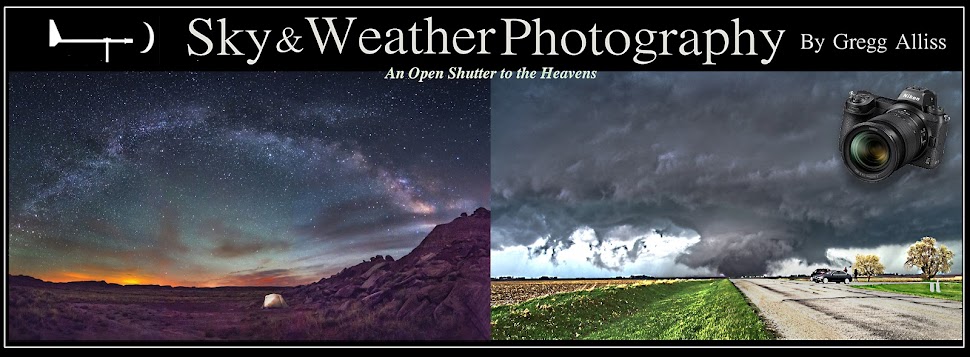New Mexico Wall Cloud
Friday, January 6, 2017
Another image from my May 16, 2016 storm chase in NE New Mexico, Oklahoma and Texas panhandles. This image shows a low-based wall cloud organizing under a growing supercell as seen from Highway 406 at A081 (Seneca Road, background) in northeast New Mexico. Camera looks ENE at 3:03 pm MDT. The storm is moving away and to the right in the image, toward the nearby panhandle of Oklahoma. A tornado would form from this cell about a half-hour later, near the town of Felt, located about 18.7 miles to the southeast. Nikon D7200 DSLR camera.






2 comments:
Hi Greg,
I have a question about your Jan 9, 2011 image of Mercury near greatest elongation (GE). What camera did you use to take that image? Digital (cell type), DSLR or SLR. If you have the name and model of the camera, I can look up all of the info I need. Otherwise, you posted the f/ratio, but can you provide more details about the lens size (if SLR was it 35mm or ?), if digital, how many in Y and Y and the pixels dimensions or the name of the sensor type. Do you happen to know the exact time that you took this image?
The reason I am asking all this stuff is that I am an astronomy prof at Connecticut College and I would like to have my students measure Mercury's and Venus' elongation angle at ge from you image if I can't capture one of my own on 1/12/2017. We are on the east coast in New England and this time of year we get a lot of clouds if not snow, so you can see why I am looking for a backup image. I don't allow the students to use any planetarium software. Hence they need to able to measure angles directly from the image so they need to setup an image scale. They may also know the exact time the image was taken as well as all of the details of the instrument used to take the image. This mimics the kind of information they would know if that took the image. From that they need to setup an image scale then calculate the distance Venus and/or Mercury is from the Sun and from the Earth (of course assuming circular orbits).
So, perhaps the first question I should have asked is, may I have permission to use your Mercury ge image from 1/9/2011 for this educational purpose? Would you be willing to share your image sensor details with me?
Thank you,
Leslie Brown
Connecticut College
Hi Leslie,
First of all, thank you for your comment. It seems like ages ago that I captured that image. The camera (mounted on a tripod) was a Nikon D5000 DSLR camera. The metadata for the image is as follows: "The planet Mercury (center, lower, in morning glow) shines in the SE sky around 6:30 AM, Sunday, January 9, 2011. The planet achieved its greatest western elongation (21 degrees) from the sun 2 1/2 hours later. The bright star between the power lines at right is Antares in the constellation Scorpius. The brightest object at right is the planet Venus. This nine-second exposure at f/6.3 and an ISO of 800 was taken along Boyson Road near Timber Oak Place in Marion, Iowa. The lights on the horizon at right are city lights from Marion. The air temperature here was -1 degrees F."
I have since upgraded to the Nikon D7200, as it a superior capacity for low-light situations which aid in my severe weather photography.
As far as permission for you to use the image--yes, absolutely. Hope it helps.
Thank you for visiting my website.
Best Regards,
Gregg Alliss
Cedar Rapids, Iowa
Post a Comment